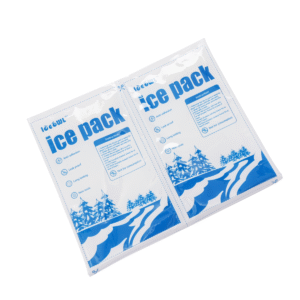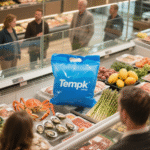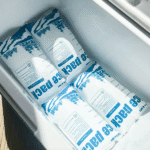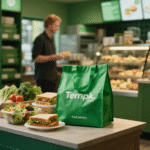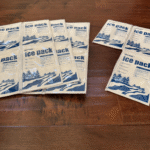Which Dry Ice Bag Kraft Paper Is Right in 2025?
You choose dry ice bag kraft paper to keep shipments cold, vent CO₂ safely, and meet labeling and food‑contact rules. Dans 2025, the best choice balances venting, wet strength, and end‑of‑life claims you can defend. This guide merges and upgrades your three drafts into one SEO‑perfected article with tools, tables, and FAQs.
-
Comment dry ice bag kraft paper fonctionne et quand l'utiliser (with long‑haul and lab lane tips)
-
Which coatings—PE, PLA, or dispersion—fit your sustainability and performance goals
-
Comment dimensionner dry ice bag kraft paper for your route and cooler class
-
What to print and place for UN1845 dry ice compliance and food‑contact records
-
2025 Façon de tendances dry ice bag kraft paper choices
What is dry ice bag kraft paper—and when should you use it?
Réponse directe: Dry ice bag kraft paper is a wet‑strength paper sleeve or bag—often micro‑vented or micro‑perforated—that holds pellets or blocks, lets CO₂ escape, shields product from abrasion, and tolerates cold and condensation. Use it when you need fiber‑based protection with compliant gas release and simple disposal.
Expanded explanation:
Think of it as a breathable jacket for your cold source. The bag shapes pellets, reduces dust, and prevents frost scuffing on pouches or cartons. Unlike sealed plastics, ventable fiber avoids pressure build‑up as dry ice sublimates at −78.5 °C. In air freight, inner packaging must vent; le extérieur package carries UN1845, Classe 9, and net dry ice weight. Choose the paper build that survives damp handling and supports your recycling or organics plan.
Do coatings change performance and recyclability?
Détails:
Coatings affect moisture resistance, sealability, and recovery. Pick the coating that matches lane risk, closure method, and disposal claims.
| Coating / Construire | Humidité & Manutention | Sealability | Ce que cela signifie pour vous |
|---|---|---|---|
| PE‑coated dry ice bag kraft paper | High splash resistance, rugged | Heat‑sealable | Tough for rough lanes; recycling acceptance varies by region—verify locally.
dry ice bag kraft paper |
| PLA‑coated kraft paper | Good resistance | Heat‑sealable | Industrially compostable when certified and when facilities accept it; not home compost.
dry ice bag kraft paper |
| Dispersion‑coated kraft paper | Moderate resistance | Heat or adhesive (varies) | Designed for mill‑friendly repulpability; check WVTR targets with supplier.
dry ice bag kraft paper |
| Uncoated wet‑strength kraft | Low barrier | Fold/tape | Best recyclability; use when cooler/liner already manages moisture.
dry ice bag kraft paper |
Conseils pratiques que vous pouvez utiliser aujourd'hui
-
Vent by design: choose micro‑perfs, pin vents, or vent patches—jamais fully seal dry ice.
-
Specify wet‑strength: PAE‑fortified papers resist tear when damp.
-
Food‑contact sanity check: keep 21 CFR Part 176 documentation when direct or incidental contact is possible.
Cas réel: A seafood shipper adopted dispersion‑coated, micro‑vented dry ice bag kraft paper, cutting pellet dust complaints and keeping air‑cargo acceptance smooth thanks to explicit venting language on the spec sheet.
How do you size dry ice bag kraft paper for your route?
Réponse directe: Start from hold‑time, charge utile, insulation class, et profil ambiant. Back‑solve to ice mass, then choose dry ice bag kraft paper that keeps shape, vents reliably, and survives moisture without creating airtight seals.
Expanded explanation:
Sublimation depends on heat gain. A common starting point is ~ 5 à 10 lb par 24h for insulated shippers, then adjust for summer lanes, openings, and box volume. The bag doesn’t “add cold”; il protects the cold—reducing pellet loss and wet tearing that can accelerate sublimation. Validate with two seasons of lane tests and temperature loggers.
Copy‑and‑use “Lane Profiler” (liste de contrôle interactive)
| Hold‑time target | Dry ice mass | Dry ice bag kraft paper build | Why this pairing |
|---|---|---|---|
| ≤ 24 h, premium cooler | 5–7lb | Uncoated wet‑strength | Lightest coating; easy recycling where accepted.
dry ice bag kraft paper |
| 24–48h, standard cooler | 8–12 lb | Dispersion‑coated | Splash resistance + repulpability focus.
dry ice bag kraft paper |
| > 48h, rough handling | 12–16 lb | PE‑coated with vents | Abuse tolerance; check local recovery options.
dry ice bag kraft paper |
| Compost‑forward programs | 8–12 lb | Certified PLA‑coated | Only where industrial composting access exists.
dry ice bag kraft paper |
Field tips that reduce shrink
-
Pre‑chill shippers and payload.
-
Place dry ice above and below product; jamais trap gas.
-
Fill voids with kraft dunnage to slow warm air intrusion.
How does dry ice bag kraft paper keep you compliant and safe?
Réponse directe: Packages must vent CO₂, survive cold and moisture, and keep documentation tight. Pour l'air: inner package vents; extérieur shipper shows UN1845, Classe9, et net dry ice weight. Train teams to ventilate vehicles and rooms; CO₂ limites: 5,000 ppm TWA and 30,000 ppm STEL. Keep 21 CFR Part 176 letters when food contact is possible.
Expanded explanation:
Dry ice is odorless and heavy; gas pools in low areas. Open doors, crack van windows, and avoid sealed trunks. Post CO₂ limits at packout stations. Keep SDS access handy. For labels, print the proper shipping name («Glace sèche» ou «dioxyde de carbone, solide"), Et1845, Class 9 mark, and net weight in kilograms on the extérieur récipient. Your dry ice bag kraft paper sleeve stays unsealed and un‑labeled inside. Archive supplier compliance letters for coatings, inks, and adhesives.
One‑minute labeling checklist (air)
-
Nom d'expédition approprié + UN1845 on the outer shipper
-
Class 9 hazard label positioned per carrier requirements
-
Net dry ice weight (kg) visible and accurate
-
Names/addresses of shipper and recipient
-
Inner dry ice bag kraft paper is vented (micro‑perfs, patch, or notch)
Dry ice bag kraft paper vs. plastic or waxed alternatives—what’s best?
Réponse directe: Dry ice bag kraft paper is safer for venting and often wins on sustainability; plastic may add barrier but risks trapped gas and brittleness at cryo temps. Choose fiber when you want compliant venting and clearer end‑of‑life options.
Side‑by‑side comparison
| Attribut | Dry ice bag kraft paper | Plastique / waxed liners | Ce que cela signifie pour vous |
|---|---|---|---|
| Ventilation & pression | Natural breathability; micro‑perfs | Often airtight unless engineered | Lower rupture risk; smoother air acceptance |
| Cold durability | Wet‑strength grades resist tear | Some plastics get brittle | Fewer failure claims in rough handling |
| Insulation role | Works with EPS/VIP; adds buffering | Needs added insulation | Longer hold time per pound of ice |
| Fin de vie | Recyclable/repulpable or compostable (when certified and accepted) | Limited recovery; landfill‑prone | Stronger ESG story and clear guidance
dry ice bag kraft paper |
Cas réel: A clinical‑trial site replaced sealed plastic sleeves with micro‑vented dry ice bag kraft paper and recorded zero “bloated bag” incidents plus ~12% less ice usage across three metros.
2025 trends in dry ice bag kraft paper and cold chain
Aperçu de la tendance (2025):
Dispersion‑coated “mill‑friendly” barriers advance repulpability without heavy polymers. PLA stacks target certified industrial composting where access exists. More shippers publish regional disposal guidance and test designs with mills and MRFs before scale. Expect portfolio strategies: uncoated for short lanes, dispersion for recovery, PLA for organics, and PE for abuse‑heavy routes.
Dernières avancées en un coup d'œil
-
Dispersion‑coat 2.0: better splash resistance with mill‑friendly recovery
-
Compostable barrier stacks: PLA‑based systems for programs with real access
-
Validation first: logger‑backed trials with suppliers, mills, and converters before rollout
Perspicacité du marché:
Acceptance of poly‑coated fiber is still uneven in North America, while organics access varies city‑to‑city. Leaders now print localized disposal copy or offer take‑back. The buying shift favors clear claims over broad recyclability marketing.
FAQ
1) Do dry ice bags have to be vented?
Oui. Dry ice bag kraft paper should include micro‑perfs or vent paths. Never trap CO₂ in an airtight liner.
2) Where do UN1845 labels go?
On the extérieur package with proper shipping name, Étiquette de classe9, and net dry ice weight. The inner dry ice bag kraft paper remains un‑labeled but vented.
3) Is PLA‑coated kraft paper compostable everywhere?
Non. C'est industrially compostable only when certified and where facilities accept it—verify local access.
4) Is PE‑coated kraft “recyclable”?
Parfois, depending on local programs and mills; avoid blanket claims and publish region‑specific guidance.
5) What about worker safety?
Ventilate pack rooms and vehicles. Keep OSHA/NIOSH CO₂ limits visible: 5,000 ppm twa; 30,000 PPM Stel. Train teams and avoid breathing cold plumes.
Pro tips & quick wins for users
-
Hot‑lane summer runs: add +2 lb dry ice per 10 °C above 25 °C and switch to dispersion‑coated dry ice bag kraft paper to keep recovery options.
-
Rough handling hubs: choose PE‑coated dry ice bag kraft paper with reinforced seams and vent patches.
-
Food contact risk: keep 21 CFR Part 176 letters on file and restrict ink sets accordingly.
Exemple de terrain: A regional seafood brand paired dispersion‑coated dry ice bag kraft paper with pre‑chilled shippers and cut condensation on outers while maintaining lane performance.
Résumé & étapes suivantes
Points clés: Choisir dry ice bag kraft paper that vents reliably, resists wet tearing, and matches real end‑of‑life access. Put labels on the extérieur expéditeur, keep food‑contact documents, and validate with data loggers before scale. Publish local disposal guidance to avoid greenwashing.
Plan d'action:
-
Map summer/winter lanes and size ice with the Lane Profiler.
-
Select coating by lane risk and disposal access.
-
Pilot three shipments per lane with loggers.
-
Train teams on venting, étiquettes, and CO₂ safety.
-
Publish simple “recycle/compost/landfill” instructions by ZIP.
À propos du tempk
We design evidence‑based cold‑chain packaging with dry ice bag kraft paper options in uncoated wet‑strength, dispersion‑coated, PE‑coated, and PLA‑coated builds—each with validated venting. We support IATA and 21 CFR documentation and run packout trials to right‑size cost and risk. CTA: Book a 15‑minute consult to spec the right bag for your lane.






